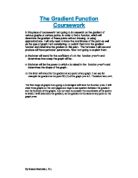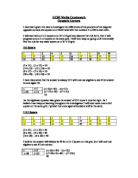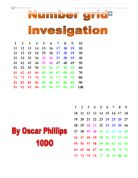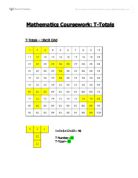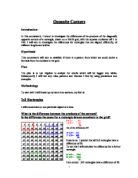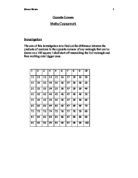T-total coursework
Part 1 Investigate the relationship between the T-total and the T-number 2 3 4 5 6 7 8 9 0 1 2 3 4 5 6 7 8 9 20 21 22 23 24 25 26 27 28 29 30 31 32 33 34 35 36 37 38 39 40 41 42 43 44 45 46 47 48 49 50 51 52 53 54 55 56 57 58 59 60 61 62 63 64 65 66 67 68 69 70 71 72 73 74 75 76 77 78 79 80 81 2 3 0 1 2 9 20 21 The T-number is always the number at the bottom of the T, so in this case (the yellow T) it is 20. The sum of all the numbers in the T is the T-total. In this case, the T-number, (which will now be called n) is 20, and the T-total, (which will now be called T) is 37. If the number at the bottom of the T is n, these are the other numbers in terms of n, bearing in mind that the width of the grid is 9 (by 9): n-19 n-18 n-17 0 n-9 2 9 n 21 The number above the T-number is (n-9) because this number is exactly one row above (n). The width of the grid is 9, so by moving up 1 cell from (n), I am decreasing the value by the width of the grid (9). The cell above (n-9) is (n-18) as the value has been decreased by the width of the grid again. The cell to the left of (n-18) is (n-19) as it has been decreased by 1. The cell to the right of (n-18) is (n-17) as it is 1 more than (n-18). When these 5 terms are added together I get: (n) + (n-9) + (n-17) + (n-18) + (n-19) = 5n - 63
The Gradient Function Coursework
The Gradient Function Coursework In this piece of coursework I am going to do research on the gradient of various graphs at various points, in order to find a function, which will determine the gradient of these points without drawing or using approximations. I will only need to know the coordinates of the point as well as the type of graph I am considering, to submit them into the gradient function and determine the gradient at this point. The formulae I will use and produce will have particular parameters. Now I am going to explain them. a: this letter will stand for the coefficient of x in the function y=ax^n and determines how steep the graph will be. n: this letter will be the power to which x is raised in the function y=ax^n and determines the shape of the graph. m: this letter will stand for the gradient at any point of any graph. I can say for example the gradient at the point P(1;1) of the graph y=x is 1. Therefore here m=1. The first range of graphs I am going to investigate will have the function y=ax. I will draw three graphs on the next pages and hope to see a pattern between the gradient and the function of the graphs. I do not need to consider the coordinates of the points at which I will determine the gradient, as the gradient is the same at any point on the graph y=ax. From these three graphs I clearly recognise a pattern. I will show how I noticed
opposite corners
GCSE Maths Coursework Opposite Corners I have been given the task to investigate the differences of the products of the diagonal opposite corners of a square on a 10x10 Grid with the numbers 1 to 100 to start with. I will start with a 2 x 2 square on a 10 x 10 grid and discover the rule for it, then I will progress onto a 3 x 3 square on the same grid. I will then keep on going until I eventually find the rule for any sized square on a 10 x 10 grid. 2x2 Square 2 3 4 5 6 7 8 9 0 1 2 3 4 5 6 7 8 9 20 21 22 23 24 25 26 27 28 29 30 (2 x 11) - (1 x 12) = 10 (14 x 25) - (15 x 24) = 10 (8 x 17) - (7 x 18) = 10 (20 x 29) - (19 x 30) = 10 I have discovered that the answer is always 10 I will now use algebra to see if the answer is once again 10. n n+1 n+10 n+11 (n+1)(n+10) - n(n+11) (n2+11n+10) - (n2+11n) 0 As the algebraic equation also gives the answer of 10 I know it must be right. As I believe I can keep on learning throughout the investigation I will now move onto a 3x3 square on the same grid. I predict that once again all answers will be the same. 3 X 3 Square 2 3 4 5 6 7 8 9 0 1 2 3 4 5 6 7 8 9 20 21 22 23 24 25 26 27 28 29 30 (3 x 21) - (1 x 23) = 40 (6 x 24) - (4 x 26) = 40 (10 x 28) - (8 x 30) = 40 I believe the answer will always be 40 for a 3 x 3 square on this grid. So I will now use algebra
Number grids. In this investigation I have been attempting to work out a formula that will find the difference between the products of the top left and bottom right of a number grid and the top right and bottom left of a number grid.
2 3 4 5 6 7 8 9 0 1 2 3 4 5 6 7 8 9 20 21 22 23 24 25 26 27 28 29 30 31 32 33 34 35 36 37 38 39 40 41 42 43 44 45 46 47 48 49 50 51 52 53 54 55 56 57 58 59 60 61 62 63 64 65 66 67 68 69 70 71 72 73 74 75 76 77 78 79 80 81 82 83 84 85 86 87 88 89 90 91 92 93 94 95 96 97 98 99 00 2 3 4 5 6 7 8 9 0 1 2 3 4 5 6 7 8 9 20 21 22 23 24 25 26 27 28 29 30 31 32 33 34 35 36 37 38 39 40 41 42 43 44 45 46 47 48 49 50 51 52 53 54 55 56 57 58 59 60 61 62 63 64 65 66 67 68 69 70 71 72 73 74 75 76 77 78 79 80 81 In this investigation I have been attempting to work out a formula that will find the difference between the products of the top left and bottom right of a number grid and the top right and bottom left of a number grid. 2 3 4 5 6 7 8 9 0 1 2 3 4 5 6 7 8 9 20 21 22 23 24 25 26 27 28 29 30 31 32 33 34 35 36 37 38 39 40 41 42 43 44 45 46 47 48 49 50 51 52 53 54 55 56 57 58 59 60 61 62 63 64 65 66 67 68 69 70 71 72 73 74 75 76 77 78 79 80 81 82 83 84 85 86 87 88 89 90 91 92 93 94 95 96 97 98 99 00 A 10x10 number grid If you choose any 2x2 box on a 10x10 number grid then the difference should equal 10...
I am going to investigate the difference between the products of the numbers in the opposite corners of any rectangle that can be drawn on a 100 square (10x10) grid
Opposite Corners Opposite Corners * Throughout this piece of work, the horizontal side will be referred to as the length, whilst the vertical side will be referred to as width. Introduction/Aim I am going to investigate the difference between the products of the numbers in the opposite corners of any rectangle that can be drawn on a 100 square (10x10) grid. I am going to investigate different rectangles, of different areas, lengths, widths and positioning on a grid. After finding a pattern, I will try and prove that it will work for other cases by using algebra and making an algebraic formula. As I go along, I will have to record any ideas I have or patterns I see. Afterwards, I will go on to investigate how this rule may differs on a different sized grid. 2x2 Square, 10x10 Grid 2 3 4 5 6 7 8 9 10 11 12 13 14 15 16 17 18 19 20 21 22 23 24 25 26 27 28 29 30 31 32 33 34 35 36 37 38 39 40 41 42 43 44 45 46 47 48 49 50 51 52 53 54 55 56 57 58 59 60 61 62 63 64 65 66 67 68 69 70 71 72 73 74 75 76 77 78 79 80 81 82 83 84 85 86 87 88 89 90 91 92 93 94 95 96 97 98 99 100 This is a 10x10 grid. On it (outlines in red) is a 2x2 square. Firstly, I’m going to see what the difference between the products of the corners is (D): 55x64=3520 54x65= 3510 3520-3510=10, D=10 Now: What
Gradient Function
Gradient Function Introduction For this project, I will deduce the gradient for several y=axn graphs and with this find any sort of relationships between the x values and the gradient. A gradient is the steepness of a curve at a point. Gradients can prove to be very useful. It usually means something in most graphs for e.g. in distance-time graphs, the gradient indicates the speed. The gradient formula for a straight line is: Gradient = Change in y Change in x However, since the y=axn forms a curve rather than a simple straight line, it is much more apprehensive to calculate its gradient. Therefore, another method has to be applied. The gradient for the non-linear graph is the steepness of a curve at one particular point. In order to find this, I will need to draw specific tangents on different x-axis points. A tangent in a non-linear graph is a straight line that essentially touches the curve at one point with two tiny alike angles either side. It must not touch more than one particular point or intersect the curve, as this will distort the outcome. As a result, we can say that the curve's steepness at a particular point is identical to the tangent formed in that specific curve. I will draw four graphs: y=x2, y=x3 y=2x2 and y=x-1. From each of these graphs I will infer different gradients and compare my results with the theoretical result that is found by using the
Opposite Corners
Opposite corners 1 2 3 4 5 6 7 8 9 10 11 12 13 14 15 16 17 18 19 20 21 22 23 24 25 26 27 28 29 30 31 32 33 34 35 36 37 38 39 40 41 42 43 44 45 46 47 48 49 50 51 52 53 54 55 56 57 58 59 60 61 62 63 64 65 66 67 68 69 70 71 72 73 74 75 76 77 78 79 80 81 82 83 84 85 86 87 88 89 90 91 92 93 94 95 96 97 98 99 00 On a 10*10 square grid, choose any 2*2 square, multiply the corners in that grid and then find the difference between the two corners investigate. 2 13 12 13 16 17 16 17 22 23 * 23 * 22 26 27 * 27 * 26 276 284 332 342 284-276=10 342-332=10 Difference=10 The two answers are the same. I think it would be the same for any 2*2 square. To prove this I will use algebra to show that in any 2*2 square the difference will 10. z- number in the top left corner z z+1 z(z+11)=z²+11z z+10z+11 (z+1)(z+10)=z²+11z+10 (z²+11z+10)-(z²+11z)=10 Difference = 10 This proves that with any 2*2 square the corners multiplied then subtracted always = 10 To further my investigations I am now going to
Opposite Corners. In this coursework, to find a formula from a set of numbers with different square sizes in opposite corners is the aim. The discovery of the formula will help in finding solutions to the tasks ahead as well as patterns involving Opposite
Introduction: The mathematical investigations that are about to be undertaken are all under one puzzle called Opposite Corners. In this coursework, to find a formula from a set of numbers with different square sizes in opposite corners is the aim. The discovery of the formula will help in finding solutions to the tasks ahead as well as patterns involving Opposite Corners. There are a few basic procedures to follow to achieve a basic understanding of the whole puzzle. A box consisting of numbers from 1 to 100, a 10 by 10 grid (arranged in a regular pattern) will aid in initiating an understanding for this piece. Procedure: . Place borders of four lines in order to enclose numbers arranged in a given grid. The enclosed numbers should form a perfect square. 2. Multiply the numbers that are found diagonally opposite and placed in the four corners of the box. 3. From the products obtained after multiplying, find the difference between them. An example is demonstrated on the next page. Below is a 10 by 10 grid. Here the numbers are arranged in 10 columns. 2 3 4 5 6 7 8 9 0 1 2 3 4 5 6 7 8 9 20 21 22 23 24 25 26 27 28 29 30 31 32 33 34 35 36 37 38 39 40 41 42 43 44 45 46 47 48 49 50 51 52 53 54 55 56 57 58 59 60 61 62 63 64 65 66 67 68 69 70 71 72 73 74 75 76 77 78 79 80 81 82 83 84 85
I am going to investigate by taking a square shape of numbers from a grid, and then I multiply the opposite corners to find the difference of these two results. Firstly I am going to start with a 10x10 grid
Gcse Math's - number grid coursework I am going to investigate by taking a square shape of numbers from a grid, and then I multiply the opposite corners to find the difference of these two results. Firstly I am going to start with a 10x10 grid and pick up 4 different squares, I will start with the 2x2 square. Then I move on and use the 3x3, 4x4 and the 5x5 square. number Left corner x right corner Right corner x left corner Products difference 3x24=312 4x23=322 0 2 4x25=350 5x24=360 0 3 25x36=900 26x35=910 0 I have noticed that the products difference of 2x2 squares in a 10x10 grid equal to 10. I predict if I move the 2x2 square to the right or down I will get the same answer. 4 34x45=1530 35x44=1540 0 My prediction is right. I am going to use algebra to test my results. n n+1 n+10 n+11 (n+1)(n+10)=n²+10+11n n(n+11)=n²+11n Products difference is equal to (n²+10+11n) - (n²+11n) =10 In the same grid I will now work out a 3x3 square. number Left corner x right corner Right corner x left corner Products difference 5 5x37=555 7x35=595 40 6 6x24=144 4x26=104 40 7 6x38=608 8x36=648 40 I have noticed that the products difference of 3x3 squares in a 10x10 grid equal to 40. I predict if I move the 3x3 square to the right or up I will get the same answer. 8 26x48=1248 28x46=1288 40 My prediction is right. I am going to
T-TOTALS
Mathematics Coursework: T-Totals T-Totals - 10x10 Grid 1+2+3+12+22= 40 T-Number=22 T-Total= 40 24+25+26+35+45= 145 T-Number=45 T-Total=145 61+62+63+72+82= 340 T-Number=82 T-Total=340 78+79+80+89+99= 425 T-Number=99 T-Total=425 For 10x10 Grid: * When the T-number is even, so is the T-Total. * When the T-number is odd, so is the T-Total. I will now find the rule which links the T-Number with the T-Total: n+(n-10)+(n-20)+ (n-21)+(n-19) =5n-70 When n= 59 =(5x59)-70=225 Testing: 38+39+40+49+59=225 As you can see my rule has worked. 9x9 Grid: 1+2+3+11+20= 37 T-Number=20 T-Total= 37 22+23+24+32+41= 142 T-Number=41 T-Total=142 46+47+48+56+65= 262 T-Number=65 T-Total=262 61+62+63+71+80=337 T-Number=80 T-Total=337 For 9x9 Grid: * When the T-Number is even, the T-Total is odd. * When the T-Number is odd, the T-Total is even. I will now find a rule which links the T-number with the T-Total: n+(n-9)+(n-18)+ (n-18)+(n-19) =5n-63 When n=44 =(5x44)-63=157 Testing 25+26+27+35+44=157 8x8 Grid 1+2+3+10+18= 34 T-Number=18 T-Total=34 20+21+22+29+37= 129 T-Number=37 T-Total=129 33+34+35+42+50= 194 T-Number= 50 T-Total= 194 45+46+47+54+62= 254 T-Number= 62 T-Total= 254 For 8x8 Grid: * When the T-Number is odd, the T-Total is odd. * When the T-Number is even, the T-Total is even. I will now find a rule which




